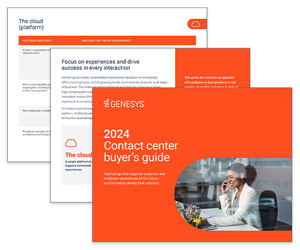Our experts reveal how you can start improving your customer service right now.
1. Start offering proactive customer service
The key here is to contact your customers before they need to pick up the phone and contact you! To be effective, these contacts should be timely, personalised and relevant to the consumer.
The best proactive strategies make regular contact throughout the consumer lifecycle.
Examples include:
- Payment reminders
- Fraud monitoring
- Personalised loyalty and reward schemes
This strategy can reduce inbound calls and improve agent efficiency. This proves that offering great customer service isn’t just good for the consumer, it’s good for the business as well.
2. Close the loop on customer surveys by segmenting your customers
When it comes to feedback surveys, the majority of companies are guilty of sending out a generic “thank you for completing this survey” message – regardless of whether a customer has praised their services or is on the brink of creating a social media PR nightmare.
A better way to manage survey responses is to segment your customers into promoters and detractors, and follow up appropriately.

Frank Sherlock
This strategy will allow you to get the best out of your promoters – by encouraging them to take part in your “tell a friend” campaign, while simultaneously targeting your detractors with a follow-up call from your customer care team.
Overall, this can help you to limit brand damage and reduce churn.
With thanks to Frank Sherlock at Genesys
3. Don’t walk away from tried and trusted metrics
It is easy to get distracted by the latest metrics. In my experience, however, they tend to be fads. What is popular one month isn’t the next, and if you keep on switching you will never fully understand the customer journey.
To counteract this, you should decide which metrics work best for you – First Contact Resolution, Customer Effort and agent friendliness normally form a good baseline. Stick to them. This way you will build a true picture of what is really working in your contact centre.
4. Separate agent-caused problems from system-caused problems
When analysing the results of customer feedback surveys, it is all too easy to blend agent-caused problems with system-caused problems. Smart organisations isolate agent-caused problems from system-caused ones, in order to get to the root of the problem – and solve it!
When designing your customer feedback questions, you should make sure that you clearly separate agent-caused problems from system-caused ones. For maximum impact, make sure your outsourcing partners do this as well.
That way you can address any problems at the source and start making real improvements to your customer experience.
5. Monitor Repeat Contact rather than First Contact Resolution
Trying to measure First Contact Resolution (FCR) as a metric in itself can be a bit of a fool’s errand, as it is difficult to define exactly what a resolved contact is.

Mike Allen
Yet there are benefits to be found in measuring Repeat Contact rates. This is far easier to measure than FCR, and many organisations already know their top 10 reasons for repeat contact. By mapping these and focusing on fixing them, you should see some real progress and improvements in customer satisfaction.
In doing this, however, you should be prepared to acknowledge that your technology may be part of the problem. Great contact centres don’t just accept that their technology is slow! They recognise that upgrading it is just as important as training front-line staff, and work within strict deadlines when fixing it.
With thanks to Mike Allen, Practice Leader at Right First Time Contact Centre
6. Use discussion forums to increase awareness of self-assisted channels
We use discussion forums to post answers to FAQs, educate our customers and increase the awareness of self-assisted channels.
With thanks to Mostafa
7. Send text messages as appointment reminders
We contact customers the evening before by text as a reminder of their appointment.
With thanks to Iain
8. Send out automated emails when information is updated in the system
We have automated emails going to the customers once the status or information is updated in the system.
With thanks to Rahul
9. Call up the customer to confirm successful delivery
We call our customers to ensure that deliverables sent by email were actually received.
With thanks to Michael
10. Try placing a timescale on the on-hold time
Try placing a timescale on how long a caller could be placed on hold.
If the on-hold time is expected to be longer than 2 and a half minutes, the agent offers a call-back to their customer.
With thanks to Iain
11. Ask customers to grade performance on a scale of 1-6
We ask our customers to grade our performance on a scale of 1-6, so there is no middle ground.
We then ask for a short reason for that answer. Simple, but effective!
With thanks to Matt
12. Focus on eliminating waste and the IVR journey
We have done lots of work on understanding the customer journey and experience.
Our key focuses are on eliminating waste and the customer journey through the IVR.
With thanks to Julie
13. Thank the customer for their feedback – even if it’s negative!
Thank the customer for their feedback – even if it’s negative!
It’s honest and shows we take the customer’s concerns seriously.
With thanks to Matt
14. Readily provide information via your website’s homepage
Provide information readily to your customers via your website’s homepage – so that they DON’T have to contact you.
It’s easier for the customer and reduces the number of calls coming into the contact centre.
With thanks to another one of Call Centre Helper’s readers
15. Give customers the option to arrange a call-back
Our customers have the option to leave a message and then we ring them back so they are not charged for holding.
With thanks to Elaine
16. Ask about your customers’ contact preferences
We have a detailed customer support form which asks how the customer would like to be contacted.
We also carry out home visits and conduct follow-up telephone calls.
With thanks to Elaine
17. Include a link that copies the appointment to the customer’s calendar
After making an appointment, an automatized message with the appointment details is sent to the customer, including a link that copies the appointment into the customer’s calendar.
With thanks to Martin
18. Empower your agents to make the right decision
Empower your agents to make the right decision by getting them to answer three simple questions.
- Am I doing the right thing for the customer?
- Is this right for the business?
- Am I willing to take responsibility?
If your agents are empowered, this leads to a happier more knowledgeable team, and this is passed on to the customer.
With thanks to Lucy
What do you think are the best ways to improve customer service?
Author: Megan Jones
Published On: 18th Jun 2014 - Last modified: 8th Sep 2022
Read more about - Hints and Tips, Genesys


















The efficient management of social media engagement is also a crucial aspect of improving customer service. More and more interaction is occurring through the medium.
Effective communication could also improve customer service.